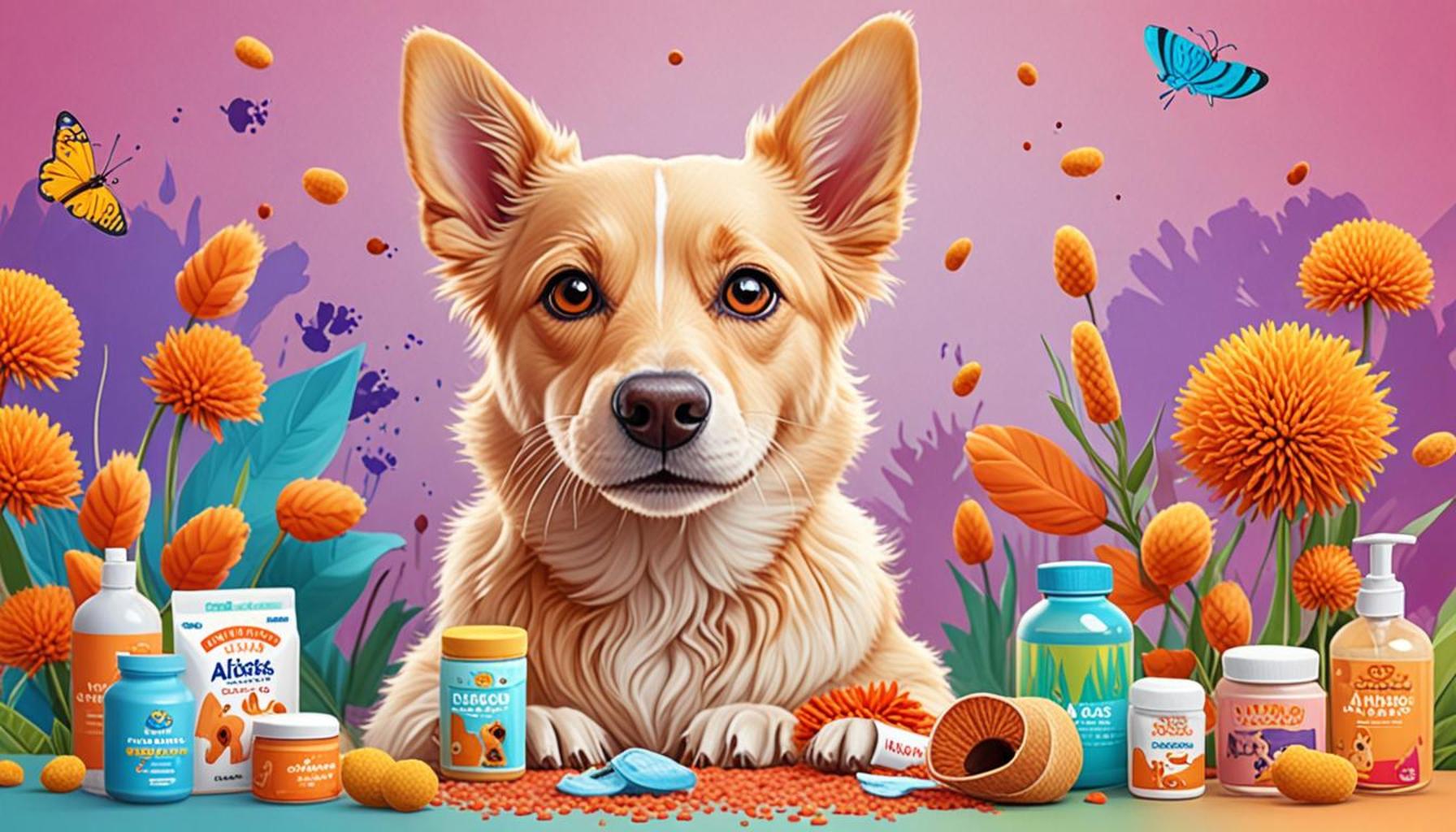How to Identify and Treat Allergies in Pets: Symptoms and Solutions

Understanding Allergies in Pets
Allergies in pets can often go unnoticed, leading to discomfort and significant health issues. As a responsible pet owner, recognizing early signs of distress in your furry companions is vital. By understanding how to identify and treat these allergies, you can ensure a happier, healthier life for your pets. In the United States, where pets are considered family members, being attuned to their health becomes even more critical.
Common Symptoms to Watch For
- Itchy Skin: Constant scratching, biting, or licking at the skin can indicate an allergic reaction. This can lead to secondary skin infections if left untreated. For instance, a dog may drag its body across the carpet or scratch incessantly, signaling an issue.
- Red or Watery Eyes: Allergies often cause inflammation around the eyes. A pet with allergies might squint or have a discharge from their eyes, similar to hay fever in humans. Noticing these symptoms can prompt an early veterinary consultation.
- Digestive Issues: Vomiting or diarrhea can occur in cases of food allergies, with ingredients like wheat or chicken protein being common culprits. If your pet experiences sudden stomach distress after changing their diet, it could be time to reconsider their food choices.
- Ear Infections: Frequent ear infections might signify allergies affecting the ear canal. A pet frequently shaking its head or exhibiting discomfort in its ears may need immediate attention to prevent serious damage.
Identifying these symptoms is just the first step. Understanding the underlying causes of allergies will significantly aid in effective treatment. Environmental factors, such as pollen, dust mites, or household cleaning products, can contribute to your pet’s discomfort. Additionally, food components or even parasites like fleas may aggravate allergies, making it vital to scrutinize all possibilities.
Exploring Solutions
Solutions can range from dietary changes to medications. For example, hypoallergenic diets may be recommended if a specific food allergy is suspected. Consulting with veterinarians is essential to develop an individualized plan tailored to your pet. They may suggest allergy testing or treatments such as antihistamines or corticosteroids, which can help manage symptoms effectively. Knowing your pet’s specific allergies allows for a proactive approach rather than a reactive one.
Taking action on these signs not only improves your pet’s quality of life but also strengthens the bond you share. An understanding of your pet’s needs enhances communication and trust between you and your furry friend. The sooner you get informed about the symptoms and solutions, the better equipped you will be in addressing your pet’s health issues, ultimately leading to a more joyful companionship.
DIVE DEEPER: Click here to learn more about puppy behavior

Identifying Allergies: The Importance of Early Detection
Allergies in pets can manifest in various ways, making early detection essential for effective treatment. Every pet is unique, and while some may exhibit clear signs, others may show subtle symptoms that could easily be overlooked. As a pet owner, being vigilant in observing your animal’s behavior and physical condition can make all the difference in managing allergies successfully.
Common Triggers of Allergies
Recognizing the potential allergens in your pet’s environment is a crucial step toward effective management. These triggers can vary widely, and understanding them will help you make informed choices regarding your pet’s care. Here are some common allergens:
- Food Allergens: Ingredients such as beef, chicken, lamb, soy, and dairy are frequently reported as allergens. When introducing new food, it’s vital to monitor your pet closely for any signs of a food allergy.
- Environmental Allergens: Pollen from grasses, trees, and weeds, as well as dust mites and mold, can cause allergic reactions. Pets that spend a significant amount of time outdoors may be more susceptible to these environmental triggers.
- Fleas and Parasites: Flea saliva is a common allergen, with some pets developing severe itching and irritation as a result of a single flea bite. Implementing routine flea prevention is fundamental to avoiding discomfort and skin issues caused by these pests.
- Household Products: Cleaning agents, air fresheners, and certain fabrics can also provoke allergic reactions in pets. Be mindful of the products you use in your home and their potential impact on your pets’ well-being.
Once you familiarize yourself with these common allergens, you will be better equipped to investigate potential issues affecting your pets. A systematic approach of elimination can often help identify the root cause of allergies. For instance, if you notice symptoms after bringing a new cleaning product into your home, it may be worthwhile to discontinue its use and observe any changes in your pet’s behavior.
The Role of Veterinary Consultation
If your pet demonstrates persistent symptoms, consulting with a veterinarian is non-negotiable. A veterinary professional can provide guidance tailored specifically to your pet’s needs, conducting tests or assessments that can pinpoint the exact nature of the allergies. They may recommend skin tests or blood tests to evaluate your pet’s sensitivity to specific allergens.
Understanding your pet’s specific allergies allows for a targeted approach in treatment, whether it involves eliminating certain foods or modifying their environment. For instance, a veterinarian may suggest an elimination diet to ascertain whether a particular ingredient is causing digestive issues. Through veterinary consultation, you’ll not only gain insight into the types of allergies your pet may have but also the best strategies to manage them effectively, leading to improved health and comfort.
In summary, timely recognition of the symptoms of allergies and knowledge of their triggers are essential in safeguarding your pet’s health. By staying informed and involved in your pet’s health journey, you strengthen the bond you have with them while ensuring they lead a happier, allergy-free life.
Understanding Allergies in Pets
Pets, like humans, can suffer from allergies that may significantly affect their quality of life. Allergies in pets can manifest in various forms, including skin irritations, gastrointestinal issues, and respiratory concerns. Common allergens include food ingredients, dust mites, pollen, and certain chemicals in cleaning products. Recognizing these allergies quickly is essential for effective treatment.
Common Symptoms of Allergies
Allergic reactions in pets often present themselves through recognizable symptoms. These may include:- Itching and Scratching: Persistent scratching or biting at their skin can lead to rashes or infections.- Red or Inflamed Skin: Areas of skin may become red, swollen, or develop hot spots.- Ear Infections: Frequent ear infections can indicate allergies, often accompanied by a foul-smelling discharge.- Gastrointestinal Distress: Vomiting, diarrhea, or flatulence can stem from food allergies.It is crucial for pet owners to monitor their pets closely and seek veterinary consultation if symptoms arise.
Treatment Options for Allergies
Once an allergy is diagnosed, treatment options may vary. Here are some strategies to consider for managing allergies in pets:- Allergen Avoidance: Removing known allergens from a pet’s environment can significantly decrease symptoms.- Medication: Antihistamines or corticosteroids prescribed by a veterinarian can help manage symptoms.- Specialized Diets: In cases of food allergies, a veterinarian may recommend an elimination diet to identify specific triggers.- Bathe Regularly: Regularly bathing your pet with hypoallergenic shampoos can help soothe irritated skin.Being proactive in addressing your pet’s allergies not only alleviates discomfort but also enhances their overall well-being.
| Category | Details |
|---|---|
| Common Allergens | Food, pollen, dust mites, and chemicals |
| Identifying Symptoms | Itching, redness, ear infections, and gastrointestinal distress |
| Treatment Options | Avoid allergens, use medication, dietary changes, and regular bathing |
Prompt veterinary attention is crucial. By understanding your pet’s allergy symptoms and exploring effective solutions, you will empower your furry friend to live a more comfortable life, free from allergy-related distress.
LEARN MORE: Click here to discover the benefits of socialization for your pet’s emotional health
Recognizing Symptoms: What to Look For
Identifying allergies in pets begins with recognizing the symptoms that often accompany allergic reactions. Unlike human allergies, which may present as sneezing or watery eyes, pets commonly exhibit a range of behaviors and physical signs that may lead you to suspect an allergic response. Early identification of these symptoms can not only help relieve your pet’s discomfort but also avoid more severe health complications down the road.
Common Symptoms of Allergies in Pets
Pets suffering from allergies often display one or more of the following symptoms, each indicating possible discomfort due to allergens:
- Itchy Skin: One of the most prevalent signs of allergies in pets is itching, frequently leading to excessive scratching, biting, or licking at certain areas of the body. This may often result in skin irritation or infections that require veterinary care.
- Ear Infections: Allergies can cause inflammation in the ears, resulting in conditions such as otitis externa. Signs include shaking of the head, scratching at the ears, or discharge from the ear canal.
- Gastrointestinal Issues: Food allergies, in particular, can lead to symptoms such as vomiting or diarrhea. If you notice ongoing digestive issues following meals, it may indicate an allergy that needs attention.
- Respiratory Problems: Though less common in pets compared to humans, some pets can develop respiratory symptoms from inhaling allergens, such as coughing, wheezing, or panting.
- Red or Watery Eyes: Allergic conjunctivitis can cause pet eyes to become red, swollen, or watery. If your pet appears to be squinting or rubbing their eyes, it could indicate an allergic reaction.
Being attentive to these symptoms allows for timely action. For instance, if your pet is frequently scratching at their ears, it may warrant a closer examination for signs of infection or underlying allergies. Documenting your pet’s symptoms over time alongside any suspected triggers can also be beneficial information for your veterinarian during consultations.
Diagnostic Approaches: What to Expect
Once allergies are suspected, the next step involves assessment and diagnosis. A veterinarian will likely conduct a thorough physical examination and may recommend one of several diagnostic tests to better understand the nature of your pet’s allergies:
- Skin Scraping: This test allows the veterinarian to examine the skin for parasites, infections, or very specific allergic reactions.
- Allergy Testing: Both intradermal skin tests (where allergenic substances are injected under the skin) and serum IgE tests (which evaluate your pet’s blood for specific allergens) are viable options to identify allergens accurately.
- Elimination Diet Trials: If a food allergy is suspected, an elimination diet trial may be implemented. This involves feeding your pet a specially formulated diet without common allergens for a predetermined period to observe symptoms.
By understanding your pet’s allergic responses and working closely with a veterinarian, you can develop a systematic approach to diagnosis and management, minimizing your pet’s discomfort and improving their quality of life. It is essential to be proactive; managing allergies effectively not only helps to ensure your pet feels better but can also enhance the bond that you share as their caregiver.
DISCOVER MORE: Click here for an in-depth comparison
Conclusion: Caring for Your Allergic Pet
Recognizing and addressing allergies in pets is essential for their overall well-being and happiness. With vigilance and understanding, you can identify the subtle symptoms your pet may exhibit, ranging from itchiness to gastrointestinal disturbances. Early detection plays a crucial role in avoiding complications, ensuring your furry friend remains active and comfortable.
Working in partnership with a veterinarian, you can navigate the diagnostic landscape effectively. Utilizing various tests and elimination diets can reveal specific allergens, allowing for tailored treatment options that cater to your pet’s unique needs. Whether it’s adjusting their diet, using antihistamines, or implementing lifestyle changes, addressing allergies is a collaborative process that leads to a healthier life for your companion.
Moreover, maintaining an allergy diary, noting your pet’s symptoms and potential triggers, not only aids in diagnosis but enhances your ability to make informed decisions. As a responsible pet owner, staying informed about allergy management strategies empowers you to provide the best care possible. Remember, your pet relies on you to recognize their discomfort and take steps to alleviate it.
In summary, a proactive approach to identifying and treating pet allergies can greatly enhance your pet’s quality of life. By staying vigilant, informed, and engaged in your pet’s health care journey, you forge a deeper bond built on compassion and understanding. Take the first step today—your beloved pet will thank you for it.


